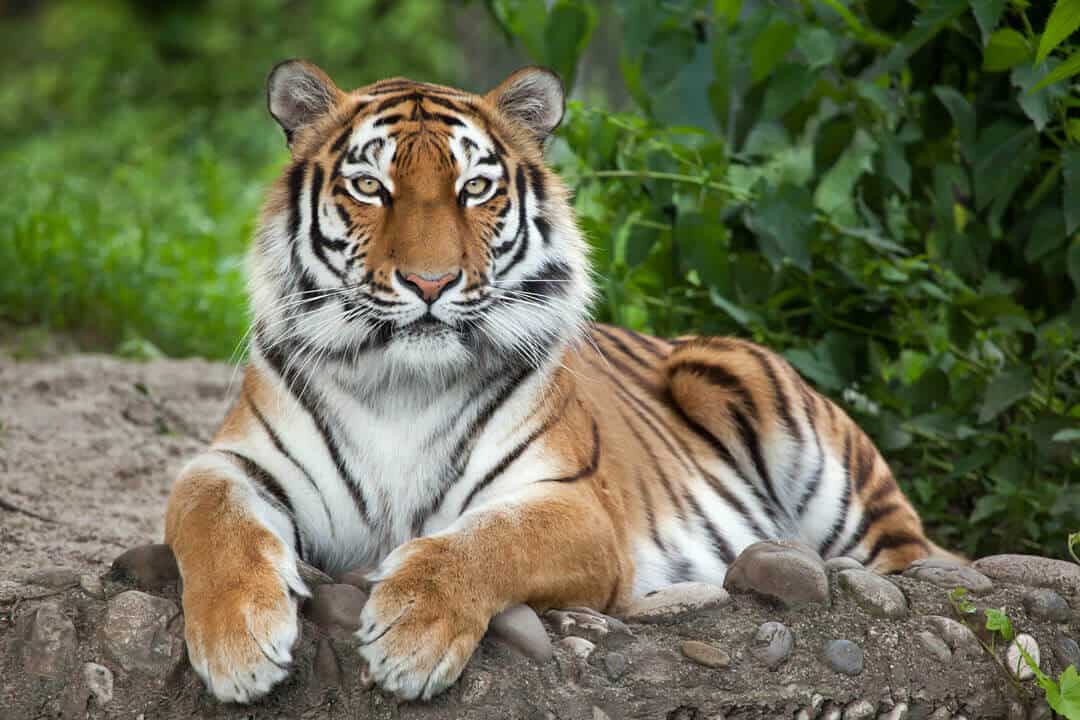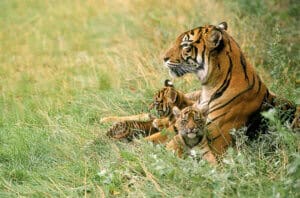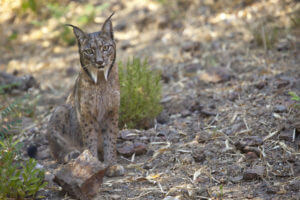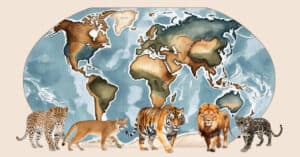The Siberian tiger, also called the Amur tiger, is a critically endangered Panthera tigris tigris population.


Scientific Name: A population of Panthera tigris tigris.
Panthera tigris tigris is the nominate tiger subspecies – the original population of a species that has been split into subspecies. Within the Panthera tigris tigris subspecies, the Siberian tiger is currently considered a clade – a group descended from a single ancestor. The Bengal, Malayan, Indochinese and South China tigers are also separate clades (populations) within this subspecies. (Note: tiger species taxonomy is currently under review by the IUCN SSC Cat Specialist Group.)
Population: It is believed there are less than 600 Siberian tigers in Russia and some along the border between Russia and China.
Lineage: The Siberian tiger is a member of the Panthera lineage, along with other tigers, the lion, jaguar, leopard, snow leopard and clouded leopard. There are two genera in this lineage: Panthera and Neofelis.
Interesting Siberian | Amur tiger facts
- Siberian tigers are the largest tigers in their species and the largest cats in the world.
- They are also known as the Manchurian tiger, Korean tiger and Ussurian tiger.
- They have less stripes than other tigers and their stripes are lighter in color.
- The stripe patterns on each tiger are unique.
- Siberian tigers can survive in the snow.
- During the 1940s, they were almost extinct due to hunting.
- They have black and white spots behind their ears.
- They are skilled swimmers and usually stay close to water sources.
- Siberan tigers have excellent night vision.

More about the Siberian tiger
Less than 600 Siberian tigers still live in the wild, most in the Russian Far East (Primorsky Krai) . Some Amur tigers can also be found in Northeast China and North Korea. The population once increased but is now declining again due to poaching.

Physical appearance
The Siberian tiger is the largest cat in the world, growing up to 11 feet long. Its fur is a cream to tawny orange color with dark brown stripes. It is somewhat thick and coarse. The Siberian tiger has a big head with long whiskers. Males can weigh as much as 700 lbs. The tiger’s tail is approximately 3 feet long. This big cat’s fur is considered relatively thick and coarse.
Origins and history
It is believed that the ancestor of the Siberian and Caspian (now extinct) tiger appeared 10,000 years ago. It travelled from eastern China to Central Asia and eventually to the Russian Far East in North Asia.
Location and habitat
Siberian tigers once roamed Northern China, the Korean peninsula, and Russia. Today, most of the remaining tigers inhabit the Sikhote-Alin Biosphere Reserve in the Primorsky Krai region of the Russian Far East. The Sikhote-Alin mountain range extends over 900 km to Vladivostok, a seaport on Golden Horn Bay near China and North Korea. Some tigers can also be found in China.
Image: Sikhote-Alin Biosphere Reserve, Primorsky Krai, Russia

Siberian tiger behavior
Siberian tigers are primarily solitary animals. They live alone except when breeding. They mark their large territories with scent to keep other tigers away.
Hunting and prey
Amur tigers prey on deer, elk, and bear, as well as small ungulates (hoofed mammals), hares, rabbits, and salmon. They roam greater distances than any other tiger subspecies to find their prey.
Mating, reproduction, and lifespan
Siberian tigers throughout the year. When a female is ready to mate, she will leave her scent and scratch marks on trees. The mating period lasts about a week, with a gestation period of around 3 1/2 months.
Female tigers have litters of two to six cubs every few years. The cubs are born blind and kept hidden in a den. The average number of cubs in a litter is two to four. Siberian tiger cubs will remain with their mothers for 2 to 3 years. They will reach maturity within three to five years.
After becoming independent, female offspring fartherusually establish a territory near their mother. Males will travel father away.
Siberian tigers live between 10 and 15 years in the wild, but they can live up to 25 years in captivity.
Siberian tiger conservation
The Siberian tiger has been hunted to near extinction for its fur and body parts. Even today, humans are still responsible for most tiger deaths.
Various conservation organizations have been working to protect the Siberian tiger, including training Primorsky province rangers to safeguard the tiger.
In 2013, Russian President Vladamir Putin signed a law imposing higher punishments for wildlife crimes, including tiger poaching and illegal trade.
Research Quotes
“The problems associated with conserving large felids in the wild are becoming more and more severe. The Amur tiger – a unique representative of the Asian faunal complex – is today only well protected in the southern Russian Far East.” – 2010 The Amur Tiger – History, Distribution, Population Dynamics, Ecology and Conservation Strategies | Pikunov, Seryodkin et al.
“Our results showed that the Amur tiger population could be viable for the next 100 years if the current habitat area and quality were well-maintained, with poaching strictly prohibited of the tigers and their main prey species.” – 2011 Population viability of the Siberian Tiger in a changing landscape: Going, going and gone? | Tian, Wu et al.
“



















I am a fan of Siberian Tigers. These days, if you look at zoos or other places like this, it seems that the birth rate of tigers is getting higher and higher. If you look at it, there is one more, so I think that even 0.1% of it will escape the extinction crisis. What I’m curious about is whether Siberian tigers are now dying more than they give birth.